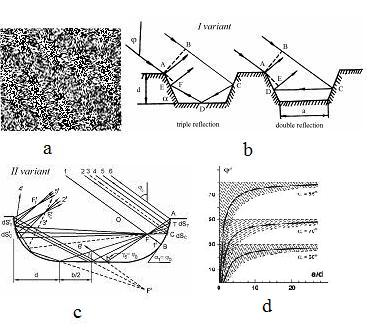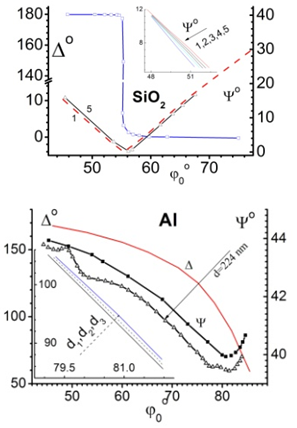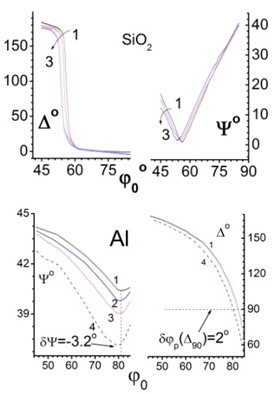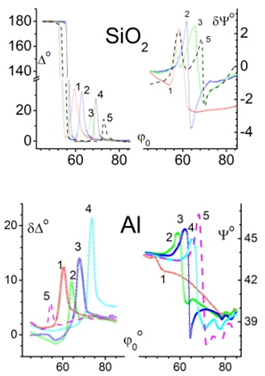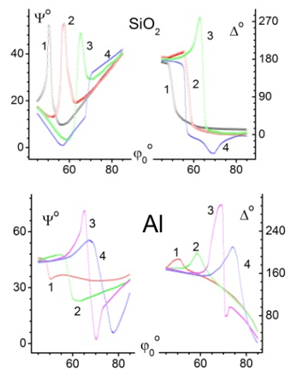-
Paper Information
- Next Paper
- Previous Paper
- Paper Submission
-
Journal Information
- About This Journal
- Editorial Board
- Current Issue
- Archive
- Author Guidelines
- Contact Us
Electrical and Electronic Engineering
p-ISSN: 2162-9455 e-ISSN: 2162-8459
2012; 2(6): 403-408
doi: 10.5923/j.eee.20120206.10
Experimental Study of Polarization Properties of Rough Surface
S. N. Svitasheva
Rzhanov Institute of Semiconductors Physics of RAS, ac. Lavrentiev Av. 13, Novosibirsk, 630090, Russia
Correspondence to: S. N. Svitasheva, Rzhanov Institute of Semiconductors Physics of RAS, ac. Lavrentiev Av. 13, Novosibirsk, 630090, Russia.
| Email: |  |
Copyright © 2012 Scientific & Academic Publishing. All Rights Reserved.
Singularities in behaviour of ellipsometric angles via functions of incidence angle of light were revealed experimentally under investigating four types of the samples manufactured on two materials: on dielectric-quartz and on metal-aluminium. Surface roughness was simulated by creation of artificial relief using a two-dimension orthogonal grating (random phase mask). Quadratic “defects” in the line were subjected to stochastic law of distribution. The “defects” were produced by etching in depth up to 1 μm and their sizes were equal to 25x25 μm and 2.5x2.5 μm on each of materials. The impact of sizes of artificial “defects” and their density upon polarization of reflected light was investigated by the multiple-angles-of-incidence ellipsometric measurements at wavelength 0.63μm. For the first time, a random phase mask was used for simulation of rough surface.
Keywords: Roughness, Optical Properties, Ellipsometry
Cite this paper: S. N. Svitasheva, "Experimental Study of Polarization Properties of Rough Surface", Electrical and Electronic Engineering, Vol. 2 No. 6, 2012, pp. 403-408. doi: 10.5923/j.eee.20120206.10.
Article Outline
1. Introduction
- The numerous attempts have been undertaken to find correlation between measurements of light scattering and the characteristics of surface roughness. Another but considerably more difficult approach is to solve the inverse scattering problem. A number of different empirical models of surface roughness have been used to characterize surfaces including sine grating, triangle grating (echelette), and rectangle grating[1-6]. Almost all above models converge to effective medium model (EMA). In this paper, we use, for the first time, the random phase mask model. The random phase (RPM) is a two-dimension orthogonal grating with the stochastic law 1/2n+1 distribution of square "defects" with sizes a×a. Our calculations of the polarizing characteristics of the RPM, and discuss the influence of each of parameters of defects on polarizing angles had been described by author[7]. The analysis was carried out for multiple- angles-of- incidence (MAI) ellipsometric measurements. It is needed to reminder that ellipsometric angles are connected with well known Fresnel reflection coefficients for p- and s-polarized light by the following relationship: Rp/Rs= tan exp (iΔ), because Rp and Rs are complex values. Interest to similar experimental works had been caused by big quantity of investigations connected with plasmon effects[8-11].Relationships obtained author[12-13] differ from formulae which were got by Heinz Raether[14] based on another theoretical prerequisites, although they look like as the similar.Two purposes of this report are to establish correlation relationship between a priory known parameters of a relief and ellipsometric angles via functions of incidence angle of light, i.e. Ψ(φ0) and Δ(φ0) and to explain observable experimental singularities of Ψ(φ0) and Δ(φ0), on the basis of the analytical formulae for RPM model using results obtained earlier in[7, 15] by summation of all partial reflected and dissipated waves. Artificial roughness of surfaces was created by the etching through a two-dimension orthogonal grating with the stochastic law 1/2 n+1 distribution of square “defects” with a size a×а. The high “defects” in horizontal lines had been organized into domains of various configurations[13]. The total areas of high and low domains are equal.
2. Experimental Techniques
- In generally, reflected field from RPM is represented by superposition of the pictures which are turning out as a result of Fraunhofer diffraction on square aperture with most probable size a[16]. All measurements were carried out at wavelength of light 0.63 μm under incidence angles φ0∈45-88 for the zero diffraction order only. Depths of a relief were varied from 0 up to 1.005 μm and their values were supervised by interference microscope. The variation of depth of a relief means the changing of a few conditions: a) condition of interference of light reflected by top-bottom cell sides, b) condition of shadowing of bottom side of RPM elementary cell, c) condition of detecting of light scattered by cell sides. Last condition is valid in restricted region of angles of incidence of light as shown in Figure 1d. To understand the further reasoning, the top view of RPM is shown in Figure 1a; two variants of cross-section of relief etched in quartz or aluminium are shown in Figure 1b,c.Changeover from one size of RPM cell to another (from 2525 μm to 2.52.5 μm) is equivalent to the changing in ~100 time of “defects” density on an investigated surface. Changeover from one material to another is equivalent to the changing at least in 20 times of intensity of a diffuse scattered light because the reflectivity of quartz is about ~4%, and of aluminium is ~ 90 % (at normal angle of incidence of the light and under the only one reflection). Theoretical analysis clearly revealed, that intensity of the dispersed beams is insignificant also its contribution in mirror -component is poorly appreciable, except for special situations, for instance, near at Brewster’s angle where reflection coefficient for p-polarized light is minimal (for metal) or equal to zero (for dielectric-quartz) or when the minimum of an interference of light reflected by the top and bottom sides is observed. Conditions of an interference are satisfied when Δ1 – the path-length difference of the beams reflected by the top and bottom sides, is multiple nπ. These conditions are valid at incidence angle φinterferen.
 | (1) |
3. Experimental Results
- Samples have been situated on ellipsometer table so that a line of “defects” coincided with the plane of incidence of the light, and corresponded to theoretical analysis of model. It was found that depth of artificial relief dramatically impact upon characteristics of reflected light.
3.1. Small Depth of Relief
- Until depth of artificial relief is small (d20110 nm) and mutual suppression of rays of light reflected by top-bottom sides does not occur, Ψ(φ0) and Δ(φ0) - polarization characteristics of light reflected by surface with artificial “defects” slightly differ from the same characteristics of smooth surface, as shown in Figure 2. The density of “defects” essentially enhances these differences provided that relief depths fit in almost the same limits. For example, in case of Al, both minimal value of Ψ at Brewster angle and value of principal angle at Δ=π/2 are changed in bounds of a few degrees (Fig. 3).
3.2. Relief Depth Closed to λ/4
- As soon as depth of artificial relief becomes sufficient for suppression of rays of light reflected by top-bottom sides, singularities in Ψ(φ0) and Δ(φ0) - polarization characteristics are arose (Fig.4). In case of dielectric, the changing in Δ is larger than in due to low reflectivity of quartz so graph used coordinates Δ−φ0 and δ−φ0. Contrary, in case of metal the amplitude changing is larger than the changing in phase because reflectivity of Al is great; and coordinates δΔ−φ0 and −φ0 is used for graph.
3.3. Impact of “Defect” Density
- The increasing of “defect” density results in proportional changes of both Ψ(φ0) and Δ(φ0) as shown in Figure 5. Besides, in case of Al, peak widths in Ψ(φ0) and Δ(φ0) are greater than in the event of fused quartz though sizes of “defect” are the same. The last experimental fact is result of great reflectivity of metal Al.
3.4. Large Depth of Relief
- Further increasing of depth of relief leads to enhancing of shadowing effect and decreasing of intensity light dispersed in zero order (or mirror direction), i.e. to the weakening of its contribution in photo-detector window. The shadowing becomes so large that contribution of light scattering by lateral and bottom sides takes negligible small value and amplitude changing (in ellipsometric angle Ψ) is almost no different in compare with smooth surface. While phase changing (in ellipsometric angle Δ) is so noticeable that they do not look like on all previous dependences of Δ(φ0) as shown in Figure 6 (upper) and the largest changing of phase angle Δ is observed at small angles of incidence of light. Besides, as seen from the same Figure, the Brewster’s angle brings noticeable distortion in polarization characteristics of light reflected from fused quartz because p-component becomes to zero. Situation is abruptly changed for analogical defects etched in aluminium: the changing in Ψ and in increments of Δ are the same as shown in Figure 6 (lower). Influence of the Brewster’s angle for metal also is apparent; the pseudo-Brewster’s angle for aluminium is approximately equal to 81 and there are singularities in Ψ -the amplitude polarization angle near 81 as shown in Figure 6 (lower). Unfortunately, it is impossible to prepare artificial roughness with cell size 2.52.5 μm by etching into depth up to 1μm. Because, size of top side of every cell is decreased to value of double depth provided that etching is isotropic.
4. Experiment Confirms Theory
- Summarizing all experimental measurements to validate correctness of theoretical analysis[7] consider how way values of depth of artificial defects impact on polarization of light reflected from rough surface in Figure 7, i.e. when singularities occur in Δ(φ0) and Ψ(φ0) dependences. Experimental measurements carried out on two sets of sample consisting from different materials: dielectric- fused quartz and metal- aluminium are very closely coincided with two curves calculated from interference conditions and with taking account of defect’s depths which were measured by independent technique
5. Conclusions
- Random Phase Mask which was suggested here as model of rough surface, has allowed to explain and to predict singularities in experimental polarization dependences of Δ(φ0) and λ(φ0). Conditions of the maximal influence of a diffused light on polarizing characteristics of rough surface are found out: a) when interference condition is fulfilled or/and b) when reflection of p-polarized light is vanished for dielectric (or is minimal for metal) at Brewster’s angle. Presence of extrema in dependences of Δ(φ0) and λ(φ0) is common phenomenon for both dielectric and metal materials, it is caused by an interference of light reflected and light diffused; and only defect’s depths define positions of these extrema. The differences (magnitude and width of extrema and their amount) in a state of polarization of light reflected from an artificial rough surface with irregular relief are defined by reflectivity of material only. The basic common behaviours and their differences are theoretically predicted and experimentally verified for dielectric and metal. These results can be useful to definition of the sizes of test structures in integrate circuit, for instance.
ACKNOWLEDGEMENTS
- Author deeply appreciates to paper of Azzam R.M.А. and Bashara N.M.[1] which attracted attention of many investigators and created new direction in ellipsometry field named as diffraction ellipsometry[20].
 Abstract
Abstract Reference
Reference Full-Text PDF
Full-Text PDF Full-Text HTML
Full-Text HTML